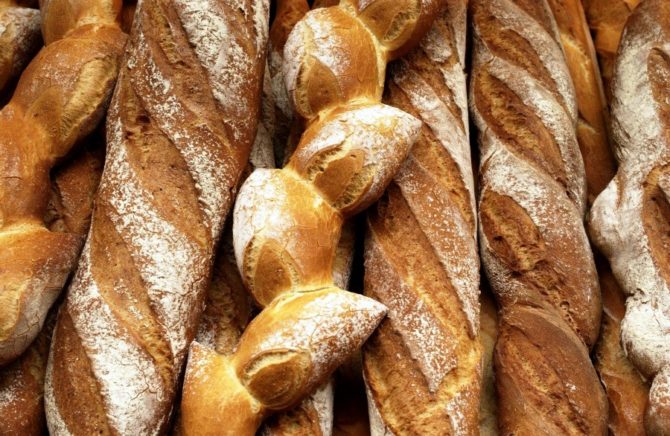Of Bakers and Baguettes

I tear the end off the baguette I’ve just purchased at Aux Blés d’Or, my favorite bakery in town, and bite into it as I walk home through the chilly mist of an early Indian summer morning. As I listen to the sounds of a French town waking up, my mouth is flooded with an intoxicating yeasty, toasty flavor.
I never tire of that first, crusty bite of baguette, though I experience it nearly every morning. It’s so fulsome, so satisfying, so comforting. It’s also reassuring, just like the golden light from the bakery that is the only one ablaze early in the morning. When everyone sleeps, the baker is in his flour-dusted domain, working so that we can eat.
Bread wasn’t always so easily had in France. The French Revolution was about bread—not the lack of it, but its price. Then, only the very wealthy could indulge. “Let them eat cake” (or brioche, as it is thought Marie Antoinette actually said) eventually led to regulated bread prices, and a hearty recipe that included three-fourths white flour and one-fourth rye so that not only could the citizenry enjoy bread, it was nutritious, too.
Today, bread prices are no longer regulated. What happens—and this is something of a well-kept secret—is that bakers regulate themselves. They decide, neighborhood by neighborhood, to “fix” the price of a baguette. That way, no one undersells anyone else. The other thing bakers do is make sure one of their profession is open in each neighborhood, every day. They stagger their days off and their vacations. Is this proof that revolutions work?
It’s more likely proof that the French adore their bread. On average, they consume about five ounces a day, and a recent poll showed that the French bakery is a French person’s favorite shop.
Conqueror’s loaf
It’s easy to understand why when you walk into Aux Blés d’Or. Not only does baker Frédéric Bénard offer more than a dozen varieties of bread, but his companion, Nadège Marais, makes each client feel as if they’ve just caused the sun to rise. She greets those she knows by name, asks about their children, their illness, their pet. For regulars, she’s got their favorite bread wrapped and ready by the time they get to the cash register. For others, she takes as much time as needed to help them decide what to purchase. Whether it be an ordinary baguette or an apple tart, the greeting and the treatment are exactly the same.
Depending on the time of day, Bénard might have come up from his basement ovens and be behind the counter too, surveying the bread supply and getting a quick glimpse of those who eat his wares. “I like to see what the clients are actually buying,” he said. “Besides, it’s fun up here!”
For Bénard, 40, there was never any doubt about what he wanted to do with his life. “I always wanted to be a baker,” he said. “I grew up in a bakery and loved it.” His mother convinced his older brothers to be bakers, and him to specialize in pastry. “I never thought about not doing what she said,” he said, laughing. “But I loved making bread so I studied that too.” He confesses to being occasionally torn between the disciplines. “One day I’ll focus more on pastries,” he said. “For now, bread keeps me busy.”
Bénard is up at 3 am, six mornings a week, to get the ovens hot, the dough mixed, the breads shaped. The whole place looks as if someone went through it with a giant sifter. “No matter how much we sweep, there’s always flour everywhere,” he said.
Aux Blés d’Or offers new varieties of bread to its clients on a regular basis. Where does Bénard get his ideas? “From the flour mills,” he said. “They offer us premixed flours and recipes. I like to offer new things to our clients.”
“New” breads might include a rustic loaf called a fagotine that is made with flour and powdered sourdough. “The powdered sourdough gives it an old-fashioned sourdough flavor,” Bénard said. “I want to make my own sourdough, but it’s tricky, and right now I don’t have time to do it.” He just introduced a fat little loaf called Hastings, le pain des conquérants (the bread of conquerors). The reference is to the Battle of Hastings in 1066, when the Norman William the Conqueror gained control of England. With its blend of rye, barley and wheat flours, and its heavy complement of sunflower and flax seeds, this Hastings could well sustain an army. Retrodor is another popular loaf made with flour ground from different wheat varieties.
Milling around
Not too far from Aux Blés d’Or, in the town of Bernay, André Sourdon, 57, works his own particular magic with bread. His specialty? Some of the same varieties as Bénard, but his methods include two major exceptions.“I grind my own flour,” Sourdon says with pride. “I’ll take you to see my mill if you’re interested.”
He didn’t have to ask twice. We jumped in his car and were soon driving down narrow country roads. We pulled off near a large timbered house with a river running through the sheep-mown backyard. We got out, went down a few steps and across a narrow bridge to an ancient mill with a small water wheel. “Here it is,” he said. “I changed all the paddles a few years ago, but other than that, I haven’t had to do anything.”
Sourdon, who has recently retired from full-time baking, paid his solemn respects to the water wheel then motioned me inside the mill. He flicked a switch. Outside, the water wheel began to turn; inside, the cogs and belts of this small mill, which was first built four hundred years ago, then refurbished a hundred years ago, began to turn. There wasn’t a creak or a crack, but a gentle, confident hum. “I grind local grain twice a year, keep the flour cold and use it every day,” he said. The resulting loaf is a whole-wheat wonder, filled with flavor, texture and life.
Back at the bakery he led the way down to his basement workspace, which smelled like a floury brewery. There, he showed me his second exception—a plastic bucket filled with puffy sourdough starter. “We use it every day,” he said. “We bakers are so privileged. We work with the beginning of life. That’s what fermentation is, that’s where it all begins.”
Sourdon agrees with Bénard on the subject of levain, or leavening. “It is tricky; you have to watch it, take its temperature, keep it stable,” he says. “You just learn how to do it, and it makes your bread fantastic.”
Bénard and Sourdon are two country bakers. One is in the middle of his career, the other is nearing retirement. Both enjoy every crumb of their business, in somewhat different ways. Each bodes well for the present and future of French bread.
BREAD AND CINNAMON CREAM TART
TARTE AU PAIN A LA CREME ET CANNELLE
The following recipe comes from the region of Alsace. I could have supplied a recipe for French bread but, really, only the bakers here do it right. So make this dessert, take a bite and close your eyes. Bread never tasted so good!
For the dough:
1 tsp active dry yeast
1 cup (250 ml) milk, heated to lukewarm
1/2 cup (100 g) sugar
3-1/2 to 3-3/4 cups (475–500 g) unbleached all-purpose flour
1 tsp fine sea salt
2 large eggs
1/2 pound (250 g or 16 tbsp) unsalted butter, cut in pieces, at room temperature
For the cream topping:
2 cups (500 ml) crème fraîche
6 tbsp vanilla sugar
1 heaping tsp ground cinnamon (preferably from Vietnam)
2 firm apples, peeled, cored and thinly sliced
1. Prepare dough: Combine yeast, milk and sugar in a large bowl or the bowl of an electric mixer, and mix well. Add 1 cup (135 g) flour and the salt and mix well. Add eggs one at a time, mixing well after each. Add enough remaining flour so dough is thick. It will be quite soft and even sticky. Don’t add more than the maximum amount of flour, as this is a soft dough—too much flour can toughen it. Knead the dough by slapping it against the sides of the bowl until it becomes quite elastic, about 10 min by hand, 5 minutes in a mixer.
2. Add butter several pieces at a time, mixing until it is incorporated. Continue kneading until dough is increasingly elastic, about 8 minutes by hand, 5 minutes in mixer.
3. Cover bowl with a damp cloth and let dough rise in a warm spot until doubled, about 1-1/2 hours.
4. Heavily butter and flour a 12-1/2 inch (32 cm) round cake pan.
5. Lightly flour hands and punch down dough so it is completely deflated. Turn dough into prepared cake pan, pressing it out nearly to the edges of the pan. Cover loosely and let rise in a warm spot until it is 2-1/2 to 3 inches high and nearly fills the pan, about 45 min.
6. Prepare topping: mix together crème fraîche and vanilla sugar.
7. Preheat oven to 400° F (200° C)
8. When dough has risen, dust three fingers with flour and poke holes all over top of dough, dipping fingers into flour occasionally so they don’t stick. Slowly pour crème fraîche over dough. Most will run into the holes, while some will run over the side. Sprinkle cinnamon evenly over top, arrange apple slices over all, place in center of oven, and bake until golden and puffed, 25 to 30 min.
9. Remove tart from oven and let cool for 5 minutes before serving.
10 servings
Susan Herrmann Loomis teaches cooking classes in Normandy and Paris. www.onruetatin.com.
Find her cookbooks in the FranceToday Bookstore
Originally published in the January 2012 issue of France Today
Share to: Facebook Twitter LinkedIn Email
Leave a reply
Your email address will not be published. Required fields are marked *



